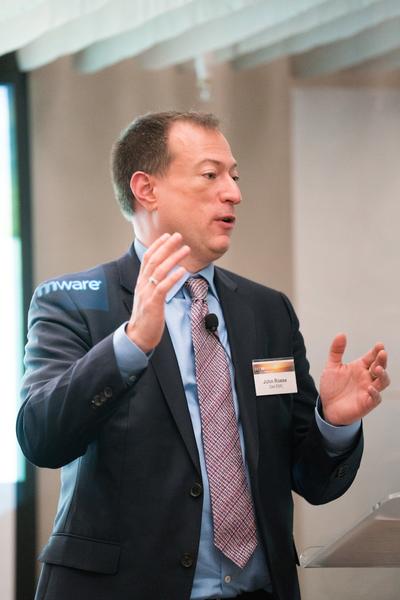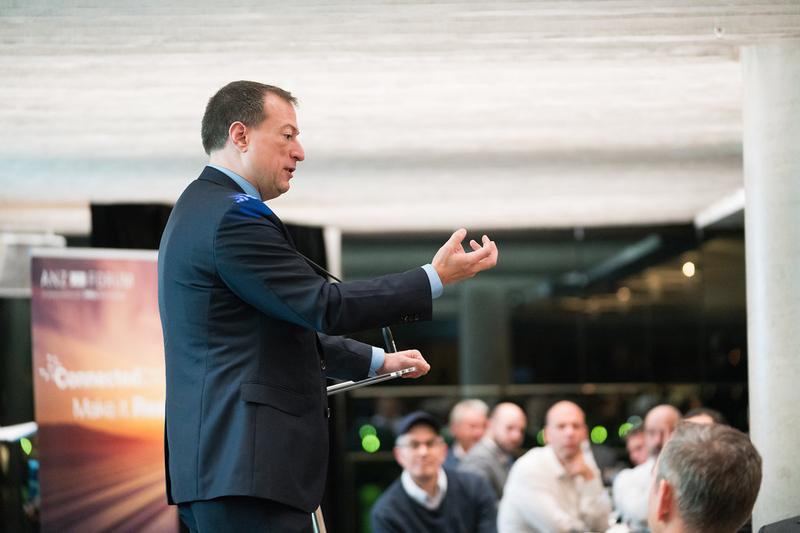Dell EMC's global CTO reveals 6 ‘big ideas’ on future of ICT industry
- 30 August, 2018 15:03

Dell's global CTO John Roese
Dell EMC’s president and global CTO, John Roese, believes we’re in a “transitional phase” in the evolution of the IT industry.
“Where we are right now is important to recognise because we’re at a transitional phase in the evolution of the IT industry,” Roese told attendees at the Dell Technologies Forum in Sydney, and later at the ANZ CIO Forum and Networking 2018 dinner.
“And we’ve been here before,” he said, explaining the early days of the Internet was a similar transitional phase.
“When we went through that evolution the entire ecosystem changed. Demand changed, our definition of customers changed, and technology evolved.
“We’ve been in an era for ten to fifteen years of what I would describe as modern IT technology. And it’s been a good era: we’ve applied technology and new ways to business processes and infrastructures, and we’ve created a tremendous amount of value.
“But this past era was characterised by primarily building technology and infrastructure that support turnkey software that came from someone else, that served end users that were principally defined as people (employees and customers) and had a scale that we could largely manage with human beings.”
While a good era to be in, he said we’re about to enter an era that will be described as the next era of human-machine partnerships.
In revealing his vision, Roese discussed the future of the ICT industry and revealed six big ideas that he said IT leaders and the IT industry, as a whole, must get comfortable with.

“These are going to be the things that actually shape our architectures, but also drive demand of these architectures going forward.”
For starters, he said the human-machine era has several implications. “We now must develop our own technology. Software competence comes back into fashion. You cannot do AI without the ability to code. You cannot do cloud native without having a core competence in software development.
“More importantly, the definition of the user is changing. We’re no longer building infrastructure to just support our employees and customers, we are connecting everything. And everything is very loosely defined and it’s going to continue to change.”
Changing mindsets
IT leaders need to start thinking differently about IT architecture and the demands of these architectures on systems.
“Our vernacular is going to change. The way we have to think has to evolve," he said.
In laying out the six big ideas, he said three of them (multi-cloud, multi-tier (or distributed IT) and software defined) define the future of the IT architecture; while the next three (IoT, AI and ML, and AR/VR) define the demands on that IT architecture and what’s new about them.
“These are buzzwords that exist out today, but we have to get beyond the buzzword to realise these are actually going to shape our infrastructure definitions and architectures and they are likely to drive more demand than anything we have ever seen in our current generation,” he said.
Touching on multi-cloud, he said the technology has revolutionised the world of IT - forced IT leaders to go through various stages of thinking - and will continue to have an impact on the future of IT.
“We have graduated from thinking about cloud as a destination or a datacentre to really understanding that it’s an operating model change. What makes a cloud a cloud is the fact that it is elastic and dynamic and delivered as a service and automated. That approach to IT started to characterise the cloud era.
“Then we progressed to realise that if we’re going to have a few clouds, on-premise and off-premise, we have to make them work together, so the concept of hybridisation came into play.
“And over the last two years, we’ve graduated to realise that even as we hybridise across clouds, we will actually build our IT infrastructures on collections of clouds because clouds are different. Some are optimised for performance and scale and some are optimised for sharing, some of them provide certain services to certain applications, but not others.”
He said the forward-thinking infrastructures will be built using collections of clouds that operate together as a system to provide the foundation of the IT environment.
“If we take another step down the stack, and move into the multi-cloud world, it’s not sufficient to just go pick a random set of clouds, we have to understand why we’re picking them. You have to think about the demands on your infrasture and make sure you have the right collection of clouds.”
Touching on the concept of multi-tier, he said IT leaders are coming to recognise that data - and the associated action and the users - is not located in the datacentres as an isolated separate concept.
“They are in the real world, they are connected cars, they are industrial systems, they are human beings walking around a city. They are smart homes and many of these systems have to operate in the real-time domain. And if all of the IT services are literally across the world in a datacentre, it’s not possible to achieve an effective outcome.
“So we’re now entering an era where multiple clouds are actually becoming distributed, and we’re starting to make decisions about where will be land compute, and how many layers and tiers will we have."
He said every industry will have to figure out what its multi-tier strategy will look like within its clouds as the industry continues to develop this next-generation of architectures.
“We’re starting to make decisions about which layer is in the cloud stack, and which function belongs in it.”
Discussing the third big idea - software defined - he said it’s a concept that will really take hold.
“You have to separate the layers of the IT stack so that innovation can happen at the appropriate speed, at the appropriate layer.
“The first principle of software definition is separate the layers. Separate hardware from software, low-level software from high-level software, application software from infrastructure software. Create a stack, properly abstract it with API’s between them that when put together deliver an IT outcome.”
Once this is done, the IT leader must then change the way it instructs the stack to operate.

“Software definition is first about layering the infrastructure stack. Second about programming it in a consistent way, and third about infinite flexibility so that you can actually adapt how your infrastructure operates based on different application delivery patterns as they evolve, without having to build a new datacentre, or evolve your infrastructure in clunky long-term ways. Speed is everything.”
Rethink connectivity
In discussing the next batch of big ideas that will shift and transform the industry, he said IoT is a hot one.
“It’s not about the things, but about the concept of suddenly changing the IT environment to provide services to people and devices and random entities that don’t behave like people.
“The actual activity is less about attaching the thing and more about adapting the infrastructure so it can actually accommodate billions of connected entities doing entirely new things, in entirely new ways.”
He said this requires IT leaders to “rethink connectivity,” how we network to these things wherever they are, and how we connect them because they’re not like a person.
Discussing AI and ML, he said the breadth of the impact is larger than anticipated, but it’s manageable.
“The problem with AI as a term is that it’s one that’s profoundly underestimated in terms of how profound of an impact it will have.”
He said there are three distinct domains where AI will completely transform humanity’s experience.
“The first is AI-applied to transform the user experience to make interacting with technology simpler for people. Great examples of this are chatbots and voice assistants.”
The second domain is AI-driven processes that will enable business productivity improvements, while the third is AI-optimised infrastructure to help solve problems that no amount of human beings can solve.
“These three areas all require a different approach. They are not the same, but they are all under the fabric of AI,” he said, explaining the IT industry has to develop new skills to address the transformative technology.
“We have to do all three. We have to have a comprehensive AI strategy, not an obsession with smart assistants and chatbots. The reason this is important is because all three have value. They improve the human condition. They make healthcare better, they make our lives easier.”
Lastly, he said the advent of AR and VR - the sixth big thing - is the growing reliance on the immersive environment.
“The wave we are just about to enter is one in which we are changing the way we engage with IT systems to become immersed within them, to blur the line between the physical world and the IT world.
“We have to rethink everything from the keyboard to the monitor. We have to add new capabilities like virtual and augmented reality tools to give you better ways to blur the line between the real world and the virtual world to present facts and data.”

